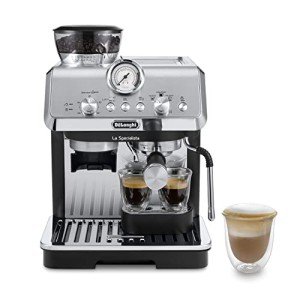The Ultimate Guide to Cappuccino Machines: Brewing the Perfect Cup
Cappuccinos are a beloved coffee beverage that integrates the abundant tastes of espresso with steamed milk and milk foam. For numerous, nothing tastes much better than a homemade cappuccino crafted with precision. However, duplicating the ability of a barista in your home needs the best devices. This is where cappuccino machines come into play. This short article looks into the different kinds of cappuccino machines, how they work, and pointers for choosing the very best one for your needs.
What is a Cappuccino Machine?
A cappuccino machine is a specialized developing gadget designed to make coffees and other espresso-based drinks. These machines typically include an integrated espresso maker, a milk frother, and numerous controls for adjusting temperature and pressure. Cappuccino machines can be manual, semi-automatic, or totally automatic, providing various levels of user control depending upon the complexity of the machine.
Types of Cappuccino Machines
1. Manual Espresso Machines
- Description: These machines require users to run most functions manually, including grinding coffee beans, tamping the premises, pulling the espresso shot, and frothing the milk.
- Pros:
- Offers complete control over the developing procedure.
- Can produce high-quality, café-like espresso.
- Cons:
- Steeper learning curve.
- Needs more time and effort.
2. Semi-Automatic Espresso Machines
- Description: Semi-automatic machines automate some procedures, such as water pressure. Users still need to grind coffee and froth milk manually.
- Pros:
- Balanced control and benefit.
- Allows room for experimentation.
- Cons:
- Still needs useful abilities.
- Can be intricate for novices.
3. Completely Automatic Espresso Machines
- Description: These machines automate the entire developing procedure, from grinding to frothing. Compact Espresso Machines select the wanted drink.
- Pros:
- Extremely practical and easy to use.
- Consistent outcomes with little effort.
- Cons:
- More expensive.
- Restricted control over the developing procedure.
4. Super Automatic Espresso Machines
- Description: Similar to completely automatic machines, but these models include functions like an integrated milk frother and grinder. They prepare drinks with simply the touch of a button.
- Pros:
- Ultimate benefit; makes numerous drinks quickly.
- Integrated cleansing and maintenance functions.
- Cons:
- High preliminary cost.
- Less hands-on experience with coffee making.
Secret Features to Consider
When selecting a cappuccino machine, several features can considerably affect efficiency and user experience. Here are some essential elements to assess:
1. Build Quality
- Materials used (stainless steel, plastic)
- Durability and longevity
2. Capacity
- Water reservoir size
- Bean hopper capacity
3. Frothing Capability
- Kind of frothing wand (manual, automatic)
- Steam pressure and temperature control
4. Alleviate of Use
- Instinctive controls
- Cleaning and upkeep requirements
5. Price
- Range from budget to high-end models
- Think about warranties and customer support choices
6. Brand name Reputation
- User reviews and skilled viewpoints
- Accessibility of replacement parts
The Brewing Process
To brew the perfect cappuccino at home, follow this procedure, regardless of the machine type:
- Prepare the Espresso: Use freshly ground coffee beans and pull a double shot (approximately 2 ounces) of espresso.
- Froth the Milk: Steam fresh milk to a temperature about 150 ° F( 65 ° C)utilizing the steam wand or automatic frother.
- Integrate: Pour the steamed milk over the espresso, followed by a layer of milk foam (equivalent parts espresso and steamed milk, with about 1 cm of foam).
For a visual representation, here's a basic table comparing the qualities of the cappuccino machine types:
| Machine Type | Control Level | Relieve of Use | Cost Range | Suitable For |
|---|---|---|---|---|
| Manual Espresso Machine | High | Difficult | Low to Medium | Coffee lovers, purists |
| Semi-Automatic Machine | Medium | Moderate | Medium | Home baristas, hobbyists |
| Totally Automatic Machine | Low | Easy | Medium to High | Casual drinkers |
| Super Automatic Machine | Very Low | Really Easy | High | Busy specialists |
Frequently Asked Questions (FAQs)
What is the best milk to use for cappuccinos?
Whole milk is typically preferred for frothing due to its fat content, which creates a creamy texture. However, alternatives like almond milk, oat milk, or soy milk can be utilized, though they may require different frothing methods.
How do I clean my cappuccino machine?
A lot of machines include particular cleaning instructions. Generally, you need to frequently clean the group head, steam wand, and drip tray. For automatic machines, numerous models feature self-cleaning cycles.
Can I use pre-ground coffee instead of entire beans?
Yes, you can use pre-ground coffee. However, freshly ground coffee typically produces a more flavorful espresso due to the oils in the beans being preserved.
Just how much should I invest in a cappuccino machine?
The rate differs considerably based on features, brand, and quality. A basic, excellent quality machine may start around ₤ 200, while high-end extremely automatic machines can go beyond ₤ 2,000.
How frequently should I replace my cappuccino machine?
With correct upkeep, a high-quality cappuccino machine can last for lots of years. However, you may think about upgrading if you discover your machine no longer fulfills your developing requires or experiences performance issues.
Cappuccino machines are powerful allies in delivering the perfect brew in your home. Whether you prefer manual interaction with your coffee or prefer the convenience of fully automated machines, comprehending the numerous types and their features will assist you in making the right option. By purchasing the ideal machine for your requirements and using the right techniques, anybody can enjoy a barista-quality cappuccino from the convenience of their own cooking area. With a bit of patience and imagination, the art of cappuccino developing can become a delightful ritual, developing not just coffee but minutes of pleasure.

